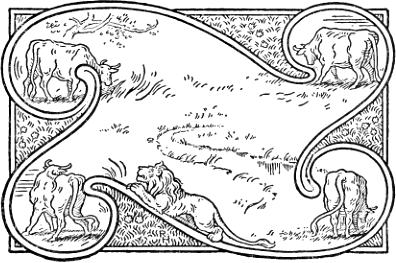The Four Oxen & The Lion
Illustrates Inter-Team Alignment, Shared Purpose, Systemic Resilience
In multi-team Agile environments, success depends on more than how well each team delivers. It hinges on how well teams align, coordinate, and protect each other from threats that no one team can solve alone. The story of the Four Oxen and The Lion1, viewed through a team of teams lens, becomes a powerful metaphor for organizational vulnerability and collective strength.

Long ago, four strong oxen lived on a vast plain. But these were no ordinary animals. Each ox represented a capable, self-organizing team. They each had their own patch of land, their own responsibilities, and their own rhythms. Though independent, they stayed in close contact. They grazed with awareness of each other's movements. When danger approached, they would back into a circle, horns facing outward, protecting one another.
A lion roamed the edge of the plain. He watched the oxen from the shadows. He studied their formation, looking for cracks.
Seasons passed. The teams grew busier. One ox became focused on efficiency and stopped checking in with the others. Another prioritized its own local objectives, choosing new grazing routes without coordination. Communication shifted from shared planning to asynchronous updates. The circle thinned.
The lion waited.
Then, one foggy morning, he made his move. He pounced, not at the strongest ox, but at the gap between two of them. The others reacted too slowly. The circle had broken.
He did not need strength to win. Only separation.
Lessons Learned
Alignment Fails Before Performance Does
The oxen were still strong. But strength is not the same as resilience. In scaled Agile systems, teams often perform well in isolation, but struggle when forced to respond together. Weak alignment is an early warning sign of system failure.
Shared Purpose Requires Ongoing Maintenance
At one time, the oxen moved with common awareness. That unity eroded not from crisis, but from neglect. In scaled delivery, shared backlogs, OKRs, or PI planning create alignment—but only if refreshed and reinforced regularly.
The Gaps Are Where the Risks Lie
The lion succeeded not by overpowering the teams, but by slipping through the space between them. Organizational risks often live in handoffs, dependencies, and assumptions between teams. These must be made visible, owned, and addressed collectively.
Synchronization Is a Defensive Mechanism
Teams that deliver in coordinated cadence protect each other. Shared planning, regular cross-team syncs, and System Demos are not ceremonies for their own sake. They are practices that allow the organization to defend itself as one body.
Independence Without Interdependence Leads to Fragility
Autonomy is powerful, but when teams forget their shared context, they weaken the whole system. In true team of teams agility, autonomy is balanced with connection, empathy, and shared accountability.
Coaching Tips
- Use Value Streams, Not Just Velocity, to Measure Progress: Local velocity may rise while the system slows. Shift conversations to how well teams deliver value together, not just how fast they move apart.
- Create Conditions for Real Alignment: Facilitate cross-team forums where context is shared, risks are discussed, and strategy becomes actionable. Go beyond status updates.
- Treat Misalignment as a Systemic Risk: When one team deprioritizes shared integration or avoids critical dependencies, it is not a local decision. It is a vulnerability that leadership must address.
- Visualize the Circle: In Retrospectives, ask teams to draw their version of the circle. Where is it strong? Where is it fraying? What would a lion exploit in our context?
- Normalize Early Help-Seeking: Teams must know that asking for help is not a sign of failure. It is how the circle stays intact. Build systems of mutual aid, not just individual ownership.
Scaled agility is not about many teams moving quickly. It is about many teams moving wisely, together. The lion is not a single disruption. It is whatever creeps in when teams forget to protect one another.
If your teams are delivering, but the outcomes feel brittle or delayed, look at the spaces between. Strength lies not in the individual ox, but in the shared formation that holds.
The most effective teams of teams build that circle on purpose. And they do not let it fade.


